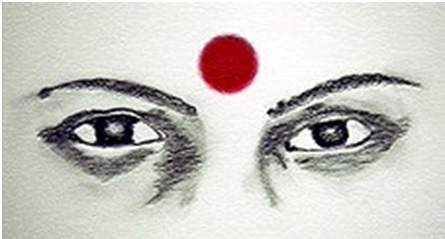
Third eye and religious symbols and warding off the evil eye. Sounds like religious fiction and not the type of stuff a modern gal like me thinks about on a regular basis? You’re wrong!
Whether you call it a bindi, pottu, thilak, bottu or bindu, this dot that adorns the foreheads of Indian women has been brought to the spotlight thanks to a wide range of pop stars. Yes it bothers me that when Madonna, Gwen Stefani or Selena Gomez wear these, it’s accepted as high fashion. Yet if I were to wear it to work with my skirt suit, it would just draw weird looks. But I’m not going to argue about cultural appropriation or analyze the perception of cultural symbols in North American society. All I want to do is clarify the significance of the pottu in the Hindu religion, an aspect that many women today (South Asian or not) may not be aware of.
Kids who have been born and raised in Canada - whether they are religious or not - know of the pottu as an Indian fashion accessory. When I am at a cultural event, I see a lot of young girls these days wear big red pottus in the name of fashion. A part of me wants to reach out and pluck it right out of their foreheads. Since that would make me appear to be a crazy pottu-grabbing lady and perhaps have other consequences, I hope some of them will come across this article. My fellow sisters, I’m writing this out of love and not out of hate. A red pottu is something special and it identifies you as a married Hindu woman. So please stop wearing it as a fashion accessory.
A pottu is not just a decoration. It has significance in the Hindu religion. It’s worn between the eyes as this point is said to be the most important pressure point, which is known as the Ajna chakra – the spiritual eye or third eye that is the place of wisdom and the center point of concentration. It is also said that the energy emerges from the base of the spine while meditating and moves to the head. Ajna chakra is the point where the energy is released. The pottu is believed to cool the forehead and prevent energy loss. If you don’t believe this, think back to the times you massaged that point when you had a headache.

Traditionally, pottu has been applied with kungumam, a red powder made of saffron or turmeric, something which is said to give many benefits. There are various sticker versions available now which may not give the same noted benefits. Regardless, the red colour of the pottu indicates the marital status of women. Call me old fashioned but a red pottu has been something special in my mind growing up, something reserved for after getting married.
If you compare this to the wedding ring, anyone can wear a ring on any of their fingers. But wearing your engagement ring or wedding band on the left ring finger is considered special and indicates your marital status to the rest of the world. It’s not very common for women to wear an engagement ring or wedding band as a fashion statement. Then how is it that we don’t give the red pottu the same amount of respect instead of using it as a mere fashion statement? After all, just as the engagement ring is considered to be a Western symbol of marriage, the red pottu is a part of our culture.
In theory, no one will stop you from wearing a pottu of any colour. Hey, I’m not the pottu police. I just wish that people would understand the significance of wearing it on the day of their wedding and showing it off proudly to the world that they are now married. The real meaning of the red pottu is lost among a lot of young women today who wear it merely as a fashion accessory. I hope anyone who understands its significance will share their knowledge with others so that its meaning is not lost in this day and age where Bollywood-inspired everything is in.
For now, I can’t seem to stop my 2 year old from my stealing my red pottus and wearing them. But when she’s old enough to understand, I will definitely help her understand the special meaning behind it.
Related articles: Coachella : Hipster Music Festival And Haven For Cultural Appropriation To Be or Not To Bindi

























